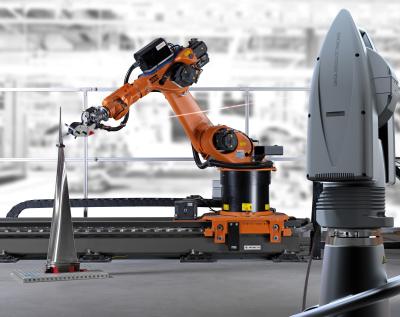
Hexagon Manufacturing Intelligence launched its latest system software release and a new Ethernet Real Time Feature Pack (RTFP) for the Leica Absolute Tracker AT960 and AT930. This combination delivers a 7DOF measurement solution designed to empower Factory of the Future applications, such as laser tracker-based machine control and robotic guidance. This technology adds a time dimension to the measurement data acquired by the laser tracker, made possible by interfacing its LMF communications with the new industrial EtherCAT protocol.
The laser tracker's 7DOF measurement capability enables real-time machine control for milling, drilling, grinding, polishing and other processes in a large-scale manufacturing environment. For example, an off-the-shelf 6-axis robot could be deployed with a Leica AT960 laser tracker and Leica T-MAC to precisely measure and correct in real-time the movement of the robot's end effector for in-place, production operations on the factory floor. The machine control system can be synchronized accordingly and corrections can be applied in real time—even in dynamic robotic setups.
“This new development is another technology brick in the Factory of the Future wall," states Joel Martin, Product Manager for Laser Tracker Software at Hexagon Manufacturing Intelligence North America. “The 7DoF measurement capability integrates our technologically mature 1000Hz 6DoF data with low latencies and highly-accurate timestamps. The robust software and firmware upgrade not only improves functionality across our laser tracker product line, but provides a major leap forward for metrology-assisted manufacturing. The 7DoF innovation is also a cornerstone of Hexagon Manufacturing Intelligence's sensing, thinking and acting philosophy to build better parts and products with speed and confidence."
Built on the industry-proven EtherCAT protocol, the laser tracker's RTFP meets the data-delivery requirements of high-end automation applications. It also adds a host of new capabilities such as cyclic data delivery with EtherCAT distributed clock support, several triggering options, and a basic command interface enabling tracker control from non-Windows environments. The new system software supports the RTFP and the recently released Leica Absolute Scanner LAS-20-8 handheld laser scanning solution. In addition to improved Tracker Pilot checks and comps, the software release includes new laser tracker service tools including preventative indicators, recertification reminders and remote technician access for a higher level of customer support.
The RTFP is available as an option with all new orders of the Leica Absolute Tracker AT960 and AT930 models or as a service retrofit. Both models can also be upgraded to the latest firmware.
Contact Details
Related Glossary Terms
- gang cutting ( milling)
gang cutting ( milling)
Machining with several cutters mounted on a single arbor, generally for simultaneous cutting.
- grinding
grinding
Machining operation in which material is removed from the workpiece by a powered abrasive wheel, stone, belt, paste, sheet, compound, slurry, etc. Takes various forms: surface grinding (creates flat and/or squared surfaces); cylindrical grinding (for external cylindrical and tapered shapes, fillets, undercuts, etc.); centerless grinding; chamfering; thread and form grinding; tool and cutter grinding; offhand grinding; lapping and polishing (grinding with extremely fine grits to create ultrasmooth surfaces); honing; and disc grinding.
- milling
milling
Machining operation in which metal or other material is removed by applying power to a rotating cutter. In vertical milling, the cutting tool is mounted vertically on the spindle. In horizontal milling, the cutting tool is mounted horizontally, either directly on the spindle or on an arbor. Horizontal milling is further broken down into conventional milling, where the cutter rotates opposite the direction of feed, or “up” into the workpiece; and climb milling, where the cutter rotates in the direction of feed, or “down” into the workpiece. Milling operations include plane or surface milling, endmilling, facemilling, angle milling, form milling and profiling.
- polishing
polishing
Abrasive process that improves surface finish and blends contours. Abrasive particles attached to a flexible backing abrade the workpiece.
